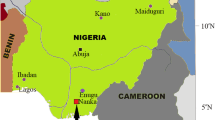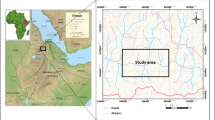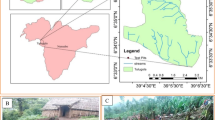Abstract
The number of landslide occurrences in Trenggalek tends to increase every year, and it represents a significant constraint on development, causing high levels of economic loss and substantial numbers of fatalities. A complete understanding of geological conditions is essential needed for spatial planning and to reduce the risk of lost lives and infrastructure damage. Surface mapping at regional scale comprised of lithology, geomorphology, geological structures, and land-use conditions was conducted in an area of 1261 km2 to develop a detailed landslide susceptibility map. The surface mapping showed that landslides commonly occurred on steep slopes of the fault-controlled hills that having inclination ranging from 16° to 28°, in the areas covered by residual soils of Mandalika Breccia unit, with high geological structure density in the settlement areas. The high susceptibility zone covered 46,75% of the research area and was characterized by having slope inclination ranging from 8° to 45°, geological units of Mandalika Breccia and Arjosari Sandstone, and land uses of settlement, dry fields, and plantation. Undisturbed soil samples collected from the high susceptibility area exemplify the clay–silt material, and XRD analysis showed the dominant clay mineral composition of halloysite and smectite. Major ion components from precipitation water, seepage, and surface water samples were used to determine hydraulic connectivity in high susceptibility zone. Both seepage and surface water indicate sodium bicarbonate-type water similar to the chemical composition of the precipitation water. The landslide mechanism in the research area is mainly controlled by lithological conditions and triggered by high rainfall.
Access provided by Autonomous University of Puebla. Download conference paper PDF
Similar content being viewed by others
Keywords
1 Introduction
Landslides are natural disasters that are controlled by geological conditions, including slopes, soil or rock types, geological structures, slope hydrology, and land use [1]. Landslides can be triggered by human activities and/or natural processes, including cutting slopes, changing slope use, vibrations/earthquakes, and rain [2]. Global climate change has increased in the intensity of rain, which has resulted in many landslides with many casualties [3]. Therefore, many researchers carry out landslide mapping with various approaches, including landslide inventory-based probabilistic approach, heuristic approach, statistical approach, and deterministic approach [4]. Some researchers also use geomorphological approaches to map landslide susceptibility [5]. Utilization of all geological parameters in landslide susceptibility mapping will give better results than using only one parameter [6]. Geographical information system (GIS) applications are widely used to support landslide susceptibility analysis using various parameters and various approach methods [7,8,9]. The accuracy of the landslide vulnerability map is greatly influenced by the map scale, mapping units, and mapping methods [10].
The research area is located in Trenggalek Regency, East Java Province, Indonesia, as shown in Fig. 1. Based on Regional Geological Map of Pacitan, Tulungagung, and Madiun Scale 1:100,000, the Trenggalek area mostly consists of Oligocene–Quaternary rocks [11]. The lithology is mostly weathered with low strength properties. The geomorphology of the Trenggalek area is the result of volcanism and is strongly affected by the geological structure, such as Puger Fault and Kambengan Fault. Land use in Trenggalek has been used for rice and dry fields (73.18%) and settlements (9.28%). Considering the relatively low population density, the development of public facilities in Trenggalek is quite feasible. However, many landslides have occurred and threatened the communities in the area, as shown in Fig. 2. Landslides have occurred in the past few years and are mostly triggered by the high rainfall, especially during the annual rainy season from October to April. Most of the Trenggalek Regency area is located on the steep slopes that were prone to a landslide. On the other hand, many residents living in disaster-prone areas of the landslide do not have sufficient knowledge regarding disaster mitigation because of the low level of education [12]. Therefore, to anticipate the impact of more significant losses and fatalities, it is necessary to research the geological conditions of Trenggalek Regency, including the landslide susceptibility.
This paper presents the result of surface geological mapping in the Trenggalek area at a regional scale comprised of lithology, geomorphology, geological structures, and land-use condition to develop a detailed landslide susceptibility map. Henceforward, this vulnerability map can be used for spatial planning purposes and to identify the main controlling factor of landslides. Lithological, geomorphological, geological structures, and land-use maps will be presented in this paper, and in the end, the main controlling factor of landslides will be highlighted.
2 Methodology
The methods used for this assessment are divided into two, namely field and laboratory investigations. Field investigations including investigations of lithology conditions, geomorphology, geological structure, precipitation and seepages water, land use, and susceptibility of the research area to landslide were conducted during surface engineering geological mapping at a regional scale.
Topographical maps analysis was conducted before fieldwork using a geographical information system (GIS) tool to support the field investigations. It combined with field observation of surface topography and active geomorphological processes to produce a geomorphological map. The research area was classified into several geomorphological units based on morphography, morphogenesis, and morphometry [13, 14].
Investigation of rock properties and geological structures was implemented, and the results were presented in a geological map and structural density map. The rocks classification genetic used were based on the classification in the regional geological map of Pacitan, Ponorogo, and Madiun area [11]. A structural density map was established upon lineaments and interpretation of geological structures found during field investigation. Field observation and interpretations of the satellite images of the existing land uses were conducted to develop a land-use map.
Slope inclination, lithology, structural density, and land-use data were used as parameters in the landslide susceptibility zonation. Each of the parameters is processed using weights of evidence method. The criteria used for landslide susceptibility zonation are shown in Table 1.
The lithological unit, slope inclination, structural density, and land-use intensity are given 52%, 20%, 20%, and 8% weights, respectively. Each parameter was then divided into several sub-parameters that were assigned a value from 1 to 3. The highest value represents the most susceptible parameter to cause a landslide, while the lower value represents the less susceptible parameter to cause a landslide. Then the score of each classification is obtained by multiplying the value by the weight. Based on the results of the calculation, the research area is then divided into three zones of low, intermediate, and high landslide susceptibilities.
As the presence of water on a slope is considered as one of triggering factors in landslides, field observation of water seepage, surface water, and precipitation water was also conducted, upon which major ion components from these water samples were used to determine hydraulic connectivity in high susceptibility zone. Soil sampling weathered rock was also carried out for XRD analysis, which aims to determine the presence of clay minerals that hold the potential to cause landslides.
3 Results and Discussion
3.1 Geological Condition
The research area consists of 11 lithological units and is divided into four geomorphological units. During the surface mapping, 62 landslides were identified. Most of the landslides were relatively small, having approximately a size of 3 m wide by 3 m high, although slightly more massive landslides that have approximately a size of 8 m wide by 8 m high were also observed.
Lithology. The lithology sequences from the oldest to the youngest unit are Mandalika lava, Mandalika breccia, intrusion, Arjosari sandstone, Campurdarat limestone, Jaten conglomerate, Wuni volcanic breccia, Oyo calcareous sandstone, Wonosari limestone, Argokalangan volcanic breccia, and alluvial. Most of the rocks in the field already weathered from slightly to completely decomposed. XRD analysis from weathered Mandalika breccia showed the dominant clay mineral composition of halloysite and smectite. Besides, minor clay minerals, such as kaolinite, plagioclase, and mica are also can be found. Halloysite is quite susceptible to changes in geotechnical characteristics. Smectite is expansive and high plasticity; therefore, it is easy to swell when infiltrated by water.
Landslides commonly occurred in the Mandalika breccia unit, which extends from the south to the north due to the absence of smectite mineral. Mandalika breccia has the widest coverage in Trenggalek, as shown in Table 2. Mandalika lava had several landslides more than Arjosari sandstone. However, Arjosari is more vulnerable due to its intense weathering and its numerous discontinuities.
Geological map of the research area is shown in Fig. 3a. Although the alluvial had no landslides occurrence, it still holds potential movement due to its loose material compositions. As the result of considerably different engineering characteristics of the geological units, the residual soils of the intrusion, Campurdarat limestone, Jaten conglomerate, Wuni volcanic breccia, Oyo calcareous sandstone, Wonosari limestone, and Argokalangan volcanic breccia have a relatively thin bed (around 0.5–1 m) and had relatively small landslides dimension.
Geomorphology. The geomorphological condition of the research area is divided into four units, as shown in Table 3.
The slope inclination map can be shown in Fig. 3b. The active surface geological processes in the steep slopes of the lava flow ridge and the fault-controlled hills were mainly erosion, while the active processes in the intermediate slopes of the fault-controlled hills and gentle slopes of the strong-eroded plain were mainly erosion and deposition.
During the field observation, 35 landslides were found in steep slope inclinations (>25°) of steep slopes of the fault-controlled hills and steep slopes of the lava flow ridge landforms, 25 were found in moderate slope inclinations (15°–25°), and two were found in gentle slope inclinations (<8°–15°) of intermediate slopes of the fault-controlled hills landform.
Geological Structures. Unlike other regions, the geological structure in Trenggalek had a significant role in the occurrence of landslides. The geological structure of either joints or faults could easily become a pathway for rainwater to weaken the rocks. The structural density map of the research area is shown in Fig. 3c.
Land-Use Condition. Land use in the study area consists of forest, bushes, plantation, dry field, paddy field, and settlement, as shown in Fig. 3d, which are then grouped into three categories, i.e., forest, rice and dry fields, and settlement. Rice and dry fields were the primary land use in the research area (73.18%), while the settlement area was only a small part of the research area (9.28%). Road cut slopes consisting of low strength soils and rocks in the research area were commonly unprotected and, therefore, prone to failure, particularly during rainy seasons.
3.2 Landslide Susceptibility
The result of the research is shown in the map of landslide susceptibility in Fig. 4. The high susceptibility zone covered approximately of 46.75% the research area and characterized by having slope inclination ranging from 8° to 45°, having geological unit consists of breccia and sandstone, having high-density geological structures, and having land use in the form of settlement, dry fields, and plantation. The moderate susceptibility zone consisted of 36.71% of the research area and characterized by having slope inclinations ranging from 8° to 45°, having geological units of alluvial, breccia, sandstone and lava, having moderate to high-density geological structures and having land use in the form of plantation and settlement. The low susceptibility zone occupied 16.54% of the research area and characterized by having slope inclination ranging from 8° to 45°, having a geological unit of alluvial, limestone, intrusion, lava, and calcareous sandstone, having low-density geological structures and having land use in the form of forest and plantation.
The result of the study shown that landslides could have occurred in the slopes from 8° to 45° and mainly located in the fault-controlled hills landform. From the wide ranges of inclinations, it is known that the slopes inclinations were not the main controlling factor of landslides in the research area. The main controlling factors of landslides in the research area are lithological conditions in which weathered intensively and formed a reasonably thick soil, dominantly composed of clay–silt material. Dominant clay mineral composition of halloysite and smectite indicates young clay minerals that quite susceptible to the change of geotechnical properties [15].
Major ion components from precipitation water, seepage, and surface water samples are collected to determine hydraulic connectivity in the hydrological system in high susceptibility zone. There are six water samples taken from several villages to be analyzed with the results, as shown in Table 4.
Both seepage and surface water indicate sodium bicarbonate type water, which is similar to the chemical composition of the precipitation water. The enrichment of calcium and chloride elements on the surface water is a result of the interaction of rainwater with rock and soil. Nglinggis and Prambon areas consist of carbonate rocks, which are members of Wonosari Limestone. It shows that precipitation water mainly seeped through the joints and other discontinuities, making the rock prone to the weathering process. The presence of discontinuity planes also acts as a weak plane that facilitates the occurrence of the soil movement.
4 Conclusion
Surface mapping at 1:25,000 scale comprised of lithology, geomorphology, geological structures, and land-use condition was conducted in an area of 1261 km2 to develop a detailed landslide susceptibility map. Landslides commonly occurred on steep slopes of the fault-controlled hills that having inclination ranging from 16° to 28°, in the areas covered by residual soils of Mandalika Breccia unit, with high geological structure density in the settlement areas. The high susceptibility zone covered 46.75% of the research area and characterized by having slope inclination ranging from 8° to 45°, having geological units of Mandalika Breccia and Arjosari Sandstone, and having land uses in the form of settlement, dry fields, and plantation. The rainfall water was confirmed as a source of groundwater in the slope that triggers a landslide according to their chemical composition. Therefore, it is necessary to control both surface and subsurface drainage on the slope.
References
Karnawati, D., Fathani, T.F., Wilopo, W., Setianto, A., Andayani, B.: Promoting the hybrid socio-technical approach for effective disaster risk reduction in developing countries. WIT Trans. Built Environ. 119, 175–182 (2011)
Fathani, T.F., Karnawati, D., Wilopo, W.: An integrated methodology to develop a standard for landslide early warning systems. Nat. Hazards Earth Syst. Sci. 16, 2123–2135 (2016). https://doi.org/10.5194/nhess-16-2123-2016
Haque, U., Silva, P.F.D., Devoli, G., Pilz, J., Zhao, B., Khaloua, A., Wilopo, W., Andersen, P., Lu, P., Lee, J., Yamamoto, T., Keellings, D., Hong, W.J., Glass, G.E.: The human cost of global warming: deadly landslides and their triggers (1995–2014). Sci. Total Environ. 682, 673–684 (2019)
Van Westen, S.J., van Ach, T.W.J., Soeters, R.: Landslide hazard and risk zonation—why is it still so difficult? Bull. Eng. Geol. Environ. 65, 167–184 (2005). https://doi.org/10.1007/s10064-005-0023-0
Van Westen, S.J., Rengers, N., Soeters, R.: Use of geomorphological information in indirect landslide susceptibility assessment. Nat. Hazards 30, 399–419 (2003)
Segoni, S., Papafico, G., Luti, T., Catani, F.: Landslide susceptibility assessment in complex geological setting: sensitivity to geological information and insights on its parameterization. Technical note. Landslides 11 (2020). https://doi.org/10.1007/s10346-019-01340-2
Casagli, N., Catani, F., Puglisi, C., Delmonco, G., Ermini, L., Margottini, C.: An inventory-based approach to landslide susceptibility assessment and its application to the Virginio River Basin, Italy. Environ. Eng. Geosci. X(3), 203–216 (2004)
He, H., Hu, D., Sun, Q., Zhu, L., Liu, Y.: A landslide susceptibility assessment method based on GIS technology and an AHP-weighted information content method: a case study of Southern Anhui, China. ISPRS Int. J. Geo-Inf. 8(266), 23 (2019). https://doi.org/10.3390/ijgi8060266
Psomiadis, E., Papazachariou, A., Soulis, K.X., Alexiou, D.S., Charalampopoulos, I.: Landslide mapping and susceptibility assessment using geospatial analysis and earth observation data. Land 9(133), 26p (2020). https://doi.org/10.3390/land9050133
Erener, A., Duzgun, H.S.B.: Landslide susceptibility assessment: what are the effects of mapping unit and mapping method? Environ. Earth Sci. 66, 859–877 (2012)
Samodra, H., Suharsono, Gafoer, S., Suwarti, T.: Geological Map of Pacitan, Tulungagung and Madiun Sheet, Scale 1: 100.000. Geological Research and Development Centre, Bandung, Indonesia (1992)
Wilopo, W., Fathani, T. F.: An integrated approach to community empowerment for disaster risk reduction; A case study in Plosorejo Village, Tawangmangu District, Karanganyar Regency. In: Proceedings of the National Seminar on Strengthening Indonesia's Resilience through Disaster Risk Reduction, Yogyakarta, Indonesia (2014) (in Indonesia language)
Lobeck, A. K.: Geomorphology, an Introduction to the Study of Landscapes, 731p. McGraw-Hill Book Company, Inc. (1939)
Verstappen, H. T.: Applied Geomorphology: Geomorphological Surveys for Environmental Development, 437p. Michigan University (1983)
Shirahata, H., Asahi, H., Oura, H.: Relationship between rock alteration and landslides in the Noboribetsu district, Southwest Hokkaido. J. Jpn. Soc. Eng. Geol. 28-2 (1987)
Acknowledgements
The research was supported by the Faculty of Engineering Universitas Gadjah Mada and Regional Disaster Management Agency of Trenggalek. Assistants of GAMA-InaTEK during the field and laboratory investigations are gratefully acknowledged.
Author information
Authors and Affiliations
Corresponding author
Editor information
Editors and Affiliations
Rights and permissions
Copyright information
© 2021 The Author(s), under exclusive license to Springer Nature Singapore Pte Ltd.
About this paper
Cite this paper
Wilopo, W., Erzagian, E., Ratri, D., Fathani, T.F. (2021). Landslide Susceptibility Assessment in Trenggalek, East Java, Indonesia: A Geological Overview. In: Hazarika, H., Madabhushi, G.S.P., Yasuhara, K., Bergado, D.T. (eds) Advances in Sustainable Construction and Resource Management. Lecture Notes in Civil Engineering, vol 144. Springer, Singapore. https://doi.org/10.1007/978-981-16-0077-7_71
Download citation
DOI: https://doi.org/10.1007/978-981-16-0077-7_71
Published:
Publisher Name: Springer, Singapore
Print ISBN: 978-981-16-0076-0
Online ISBN: 978-981-16-0077-7
eBook Packages: EngineeringEngineering (R0)








